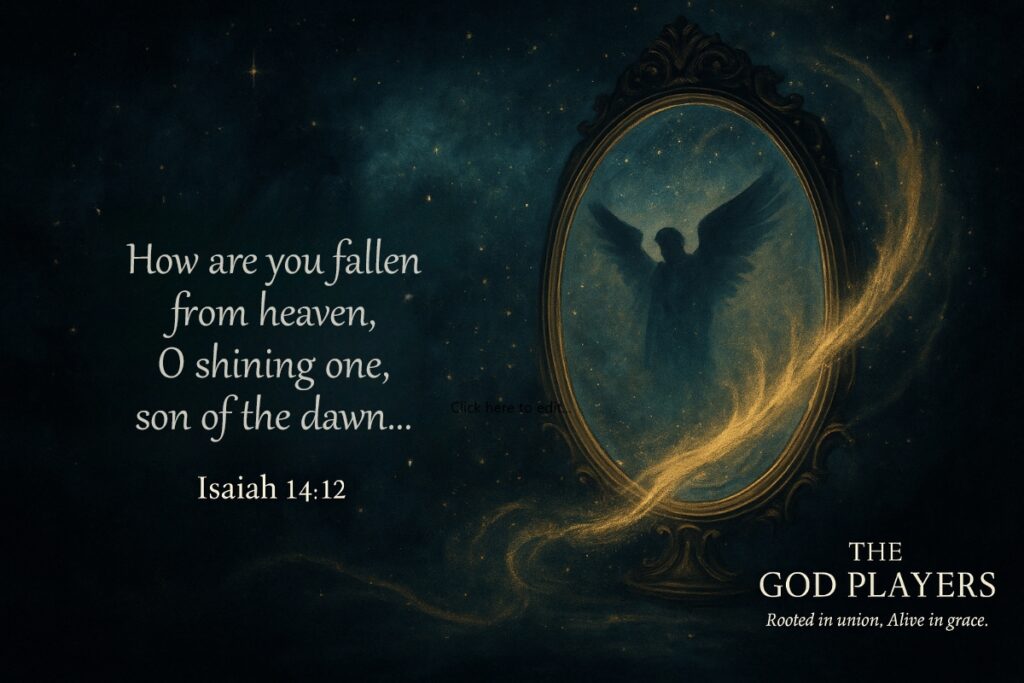Imagine It Like This
Before time wore numbers, the earth had thresholds, and light moved without resistance, among the first to reflect that light were the morning stars. Not stars as we know them, but beings of brilliance—created not to be the source, but to echo it.
Among them stood one called Helel ben Shachar – the shining one, son of the dawn.
He shone with brilliance, but the light was never his own. He reflected glory, but he did not generate it. Suddenly, within the stillness of heaven, something shifted. The mirror turned ever so slightly from the source. A desire arose to ascend above, rather than remain within. The mirror tried to become the sun.
This is where the story begins—not with evil but with dislocation. Not with rebellion in the way we imagine military coups, but with the quiet fracture of identity, a being who forgot who he was by trying to become more than he was meant to reflect.
The Misunderstood Origin (Lucifer’s Name and Story)
Most people know the name Lucifer, but few realize it doesn’t actually appear in the original Hebrew Scriptures. The name comes from the Latin translation of Isaiah 14:12:
“How you are fallen from heaven, O Lucifer, son of the morning! How you are cut down to the ground, you who weakened the nations!”
The Hebrew name is Helel ben Shachar – “shining one, son of the dawn.”
The early Church—especially Origen and Jerome—read Isaiah 14 symbolically, as a depiction of Satan’s fall from heavenly glory. But originally, the “shining one” was not Satan—it was a metaphor for Babylon’s king, who saw himself as divine but would be cast down like a fading star.
Babylon, in Scripture, becomes the image of prideful systems that exalt themselves against God. That’s why the fall of Babylon’s ruler became such a powerful symbol—not of one devil’s pride, but of all dislocated glory.
Although this passage is part of a poetic taunt against the king of Babylon, not a biographical account of Satan, over time, especially through the writings of early church figures like Augustine, it came to be interpreted as the backstory of Satan’s fall.
But what if it was never meant to be about a person, but about a pattern? The pattern of forgetting who we are. The longing to possess rather than reflect. The beginning of self-exaltation.
What the Angels See
Scripture tells us that angels rejoice when someone returns to God (Luke 15:10), and that they long to look into the mysteries of redemption (1 Peter 1:12). They are called ministering spirits (Hebrews 1:14), not judges or rivals.
Perhaps the angels did not see a “traitor” in Lucifer, but a fracture. A grief. A sorrow that something so beautiful could become so lost.
And perhaps, ever since, they have not stopped watching us in the same way—not as those waiting for us to fall, but longing to see us awaken.
Lucifer’s Mirror & Our Own
Pride is often simplified as arrogance, but beneath it lies something deeper: a misalignment of identity. Lucifer did not fall because he wanted evil—he fell because he wanted to rise alone. He forgot he was already in glory because he belonged, not because he climbed.
Jesus did not come to fix that fall with punishment. He came to restore the mirror. To remind us that we are in Him, and He in us. That glory is not something we grab, but something we reflect when we remain in union. But this can’t be told in a single day or a single story.
To Be Continued…
In Part Two, we’ll explore what happened after the light turned, what ancient texts say about other angels, demons, and the unseen realm. But for now, we sit with the first turn in the story.
Not with fear, but with clarity. Not with condemnation, but with deep longing. The angels are still watching. They are still rejoicing. They are still ministering to us as we awaken to the quiet wonder of remembrance.


